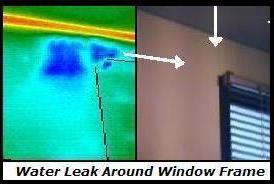If you’re interested in getting a thermal imaging ‘building envelope’ inspection on your home, it’s important that you have a small understanding of how thermal imaging works and what you’re actually getting for your money. Here’s what’s actually happening in the pictures you see on this website…
Everything you see around you (objects), be it a wall, car, wood, heater, fridge (everything) has a certain temperature and they all emit waves of energy called ‘infrared radiation’ (IR). The hotter the object, the more energy it emits. A thermal imaging camera translates these energy waves into a viewable image, which shows a “heat picture” of the object the camera is pointing towards at the time. On the actual screen of our thermal imaging camera, hotter objects show as white, cooler objects show as black, and objects in between these temperatures show up as a gray.
Here’s an example of how thermal imaging can be used outside of building inspections: Firefighters can use thermal imaging cameras to see right through smoke, as the infrared radiation that’s being emitted from ‘hot spots’ can not be blocked by smoke. This enables them to find victims faster, identify the seat of the fire earlier, detect areas that may still have a fire burning underneath rubble that they can’t see, and detect areas of structural danger and damage to the building envelope.
The actual detector we use within our thermal imaging cameras are somewhat similar to the human eye, and are very sensitive. The TI’s detector (called a focal plane array, or FPA) and the eye are both receivers. They receive electromagnetic energy and convert it into an image for our brains to interpret. The eye receives wavelengths of energy called “visible light,” while the FPA (the detector on our camera) receives wavelengths of heat energy called “infrared.”
Technically speaking, no thermal imaging camera can actually ‘see through’ solid materials. For example, in New Zealand most homes will be either build or contain at least one of the following ‘objects’ – drywall, plaster, concrete, steel, wood, paneling, down comforters, doors, sofas and the like… and non of these objects are actually ‘transparent’ to infrared. Our IR cameras can only “see” the temperature difference on any given surface.
The slightest of temperature differences on the walls in your home will show up in our cameras. EG. If you walk up to a wall in your home and place your hand flat and leave it there for 5 seconds then pull it away, the image through our camera screen will see a perfect hand shape… exactly like you would have seen had you put your hand in black paint and put it on a white wall (or vica versa depending on which object is warmer/cooler at the time). When water leaks behind your wall, it affects the surface temperature of the wall in the area of the water leak… hence why our camera will see it right away. It’s the same with air penetration through your insulation… the cool/warm air will blow onto the back on the wall… hence affecting the temperature on the surface of the wall.
It’s the air leaks, water leaks and mold growth you can’t see with the human eye that can make your ‘relaxation time’ at home very uncomfortable. We specialise in the detection of any problematic areas … usually within minutes in most cases, and totally non-invasive.
Contact us today for a infrared scan of your home!










